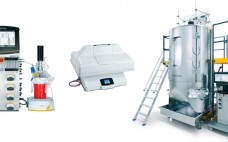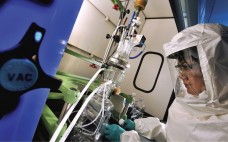Where a biopharmaceutical company does business affects its profitability — as does how it manages its facilities and even where its non–customer-facing operations are located. In fact, facilities and real estate represent some of the biggest expenses for such companies. And yet, they are often overlooked. In today’s shifting global life-sciences landscape, site selection and management strategies are coming to the forefront as companies seek operating efficiencies, access to multidisciplinary talent, and cost-effective facilities. The following insights from JLL’s 2014…
Facility Design/Engineering
Modern Laboratory Design: Creating a Space for Effective Collaboration
When asked to envision a modern biotechnology laboratory, lay persons might describe what they’ve seen on an episode of CSI: Miami. Gleaming glass and striking colored lights might look good on television, but they are not what biological researchers need to do their work most effectively. Most of the real biological laboratories I’ve visited, in fact, have been stark, white, fluorescent-lit environments that more resemble something out of 2001: A Space Odyssey. But those are becoming passĂ©. The newest concepts…
Build, Buy . . . or “Rent” Capacity? A New GMP Biomanufacturing Business Model
When it’s time to move from preclinical to clinical-phase product testing, many biopharmaceutical companies face a difficult decision: whether to build or buy a biomanufacturing facility for in-house production or outsource the work to a contract manufacturing organization (CMO). Accinov is a new company that straddles the line between those concepts. Its new biomanufacturing center supports client companies toward clinical development in an innovative way. We propose a groundbreaking model for running good manufacturing practice (GMP) biomanufacturing. Our company’s approach…
Integrated Optical Single-Use Sensors: Moving Toward a True Single-Use Factory for Biologics and Vaccine Production
Through the past decade, single-use bioreactors for culturing mammalian and insect cells have been widely adopted in preclinical, clinical, and production-scale biopharmaceutical facilities (1, 2). With such bioreactors in operation, monitoring and control of process parameters is vital for ensuring critical quality attributes (CQAs) of biologicals or vaccines are met for production of a safe product. Traditionally, bag-based and bench-top vessels have been fitted with conventional pH and dissolved oxygen (DO) probes similar to those used in stainless steel or…
Biopharma Unhappy with Suppliers’ Progress on Single-Use Hookups
Single-use equipment vendors are failing to meet their biomanufacturing customers’ expectations in several key areas, according to BioPlan Associates’ 11th Annual Report and Survey of Biopharmaceutical Manufacturing Capacity and Production (1). The study — based on a global survey of 238 global biomanufacturers and contract manufacturing organizations, as well as 158 vendors and suppliers in 30 countries — identifies significant gaps between the perceived importance of key vendor attributes and companies’ satisfaction with their vendors regarding those attributes. One area…
Process Challenges of Antibody–Drug Conjugates
With two products now on the market, and a host of others in clinical trials, antibody-drug conjugates (ADCs) are slowly becoming a big business. Designed to deliver extremely active cytotoxic drugs that are otherwise undosable, they take advantage of the targeting ability of a specifically designed monoclonal antibody (MAb) to “shield” a highly potent API (HPAPI) as it travels through a patient’s bloodstream after administration. Once the antibody reaches its target on the cancer cell, it will release the payload,…
Thinking Strategically
At the recent Phacilitate Gene and Cell Therapy Conference (27–29 January 2014 in Washington, DC), BPI’s editor in chief Anne Montgomery and publisher Brian Caine spoke with Richard Grant, executive vice president, life sciences, at Invetech (www.invetech.com.au); and Brian Hanrahan, program manager at Invetech. They and their colleagues were instrumental in advising us how to bring ongoing discussions of regenerative medicines into BPI four years ago for the first Cell Therapy Supplement issue. We asked them to comment generally on…
Single-Use, Continuous Processing of Primary Stem Cells
Many potentially therapeutic products involve the culture of stem cells. Their commercial success depends on the development of scalable good manufacturing practice (GMP) technologies that can both robustly and cost-effectively produce very large numbers of cells. Through many improvements and innovations in bioprocessing operations over the years, fed-batch suspension culture has remained the most common mode for large-scale biopharmaceutical manufacturing. However, some recent events suggest that may be changing (1,2). For the culture and expansion of stem cells, large-format adherent…
Bioprocess Advances Drive Vaccine Manufacturing in Developing Countries
Advances in bioprocessing technology hardware and genetic engineering are expanding the geographic options for biologics manufacturing to include developing and emerging economies. Such advances are beginning to permit biopharmaceutical production in regions that previously lacked the technical expertise or quality processes to permit complex operations, monitoring, record-keeping, and oversight. Global demand by countries for in-country production of biological vaccines is increasing, so those products tend to be leading the way in terms of adoption of modern bioprocessing in developing countries.…
Evolving Biologics Demand Spurs New Facility Needs
In the era of biologics manufacturing, chemical medicine production facilities are becoming the dinosaurs of the life sciences sector. Traditional chemical facility development and management systems are simply unequipped to support the highly sensitive — and highly regulated — process of developing and producing biological and biosimilar medicines. Renovating or building such facilities anew is a mammoth undertaking by any measure. All signs point to the value of evolving facility design and management to house more sophisticated biologic laboratory services.…





